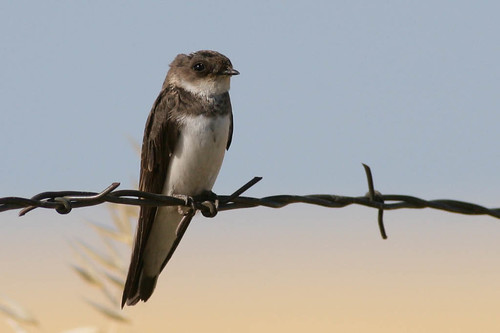The Sand Martin (Riparia riparia) / Bank Swallow is a migratory passerine bird in the swallow family. It has a wide range in summer, embracing practically the whole of Europe and the Mediterranean countries, part of northern Asia and also North America. It winters in eastern and southern Africa, South America and South Asia. It is known as Bank Swallow in North America, and as Collared Sand Martin in South Asia, and sometimes as European Sand Martin.
The 12-cm-long Sand Martin is brown above, white below with a narrow brown band on the breast; the bill is black, the legs brown. The young have rufous tips to the coverts and margins to the secondaries.
Its brown back, white throat, small size and quick jerky flight separate it at once from similar swallows, such as the House Martin (Delichon urbicum), the Cliff Swallow (Petrochelidon pyrrhonota) or other species of Riparia. Only the Banded Martin (R. cincta) of sub-Saharan Africa is similar, but the Sand Martin only occurs there in winter.
The Pale Martin is the subspecies diluta of northern India and southeastern China is sometimes split as a separate species Riparia diluta. It has paler grey-brown upperparts and a less distinct breast band. It winters in Pakistan and southern India.
The Sand Martin's twittering song is continuous when the birds are on the wing, and becomes a conversational undertone after they have settled in the roost. The harsh alarm is heard when a passing falcon, crow or other suspected predator requires combined action to drive it away.
This species was first described by Linnaeus in his Systema naturae in 1758, and originally named Hirundo riparia; the description consisted of the simple H[irundo] cinerea, gula abdomineque albis – "an ash-grey swallow, with white throat and belly" –, and the type locality was simply given as "Europa". The specific name means "of the riverbank"; it is derived from the Latin ripa "riverbank".
Its brown back, white throat, small size and quick jerky flight separate it at once from similar swallows, such as the House Martin (Delichon urbicum), the Cliff Swallow (Petrochelidon pyrrhonota) or other species of Riparia. Only the Banded Martin (R. cincta) of sub-Saharan Africa is similar, but the Sand Martin only occurs there in winter.
The Pale Martin is the subspecies diluta of northern India and southeastern China is sometimes split as a separate species Riparia diluta. It has paler grey-brown upperparts and a less distinct breast band. It winters in Pakistan and southern India.
The Sand Martin's twittering song is continuous when the birds are on the wing, and becomes a conversational undertone after they have settled in the roost. The harsh alarm is heard when a passing falcon, crow or other suspected predator requires combined action to drive it away.
This species was first described by Linnaeus in his Systema naturae in 1758, and originally named Hirundo riparia; the description consisted of the simple H[irundo] cinerea, gula abdomineque albis – "an ash-grey swallow, with white throat and belly" –, and the type locality was simply given as "Europa". The specific name means "of the riverbank"; it is derived from the Latin ripa "riverbank".





No comments:
Post a Comment